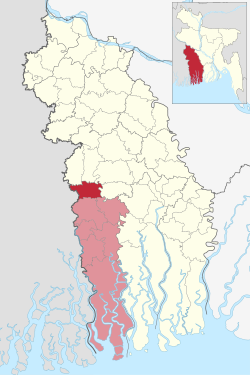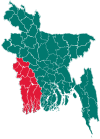|
Kalaroa Upazila
Kalaroa (Bengali: কলারোয়া) is an upazila of Satkhira District in the Division of Khulna, Bangladesh, Kolaroa Upazila was established in 1983. It is located at a distance of 18 km from the District Headquarters. Kalaroa Bazar is one of the prosperous and successful business places in Satkhira District. GeographyKalaroa is located at 22°52′30″N 89°02′30″E / 22.8750°N 89.0417°E. It has 59,282 households and a total area of 231.42 km2. Kalaroa borders Sharsha, Jhikargachha and Manirampur upazilas to the north, Satkhira Sadar and Tala upazilas to the south, Keshabpur, Manirampur and Tala upazilas and the Kobadak river to the east and Swarupnagar CD Block in North 24 Parganas district in the Indian state of West Bengal to the west.[3] The main rivers are the Kopothakho, Betraboti, Sonai, and Ichamati River. Lohakura, Kumarnal, Dhandia, Joynagar, Murari Katy, Gonopatipur, Sonabaria, Kushudanga, Tulshidanga, Batra, Sreerampur, Bujtola, Kazirhat, Khorda, Saraskati, and Chandanpur are the most famous villages in Kalaroa. DemographicsAs of the 2011 Census of Bangladesh, Kalaroa upazila had 59,282 households and a population of 266,389. 44,020 (16.52%) were under 10 years of age. Kalaroa had an average literacy rate of 50.94%, compared to the national average of 51.8%, and a sex ratio of 1037 females per 1000 males. 29,283 (12.30%) of the population lived in urban areas.[5][6] According to the 1991 Bangladesh census, Kalaroa had a population of 190,721. Males constituted 50.96% of the population, and females 49.04%. The population aged 18 or over was 97,044. Kalaroa had an average literacy rate of 25.6% (7+ years), compared to the national average of 32.4%.[7] Arts and cultureCultural organizations include 41 clubs, five public libraries, a public institute, three cinema halls, 12 women's organizations, 27 playgrounds, and a Kishore theatre. The locally published newspapers and periodicals are Pathikrit, Samatat, Suryashikha, Subarna Prasun, and Dalchhut. Religious institutions include 405 mosques, eight temples and three churches. AdministrationKalaroa Upazila is divided into Kalaroa Municipality and 12 union parishads: Chandanpur, Diara, Helatala, Jallabad, Jogikhali, Joynagar, Kaila, Keragachhi, Keralkata, Kushadanga, Langaljhara, and Sonabaria. The union parishads are subdivided into 112 mauzas and 136 villages.[8] Kalaroa Municipality is subdivided into 9 wards and 9 mahallas.[8] EducationThe oldest educational institution of Kalaroa is the Dhandia Union Institution which was established in 1915. The average literacy rate is 25.4%, 33.2% among males and 17.6% among females. There are five-degree colleges in the upazila. Honors level ones include Begum Khaleda Zia Mahabiddalay, Hazi Nasir Uddin College, Kalaroa Government College, and Sheikh Amanullah Degree College. Pass level ones include Bongobondhu Mohila College and Sonar Bangla Degree College. Other educational institutions include 4 technical institutions, 31 high schools, 6 junior high schools, 64 madrassas (notably Brozobaksha Islampur Madrasha and Kalaroa Alia Madrasha), 67 government primary schools, 45 non-government primary schools, 12 low-cost primary schools, and 5 satellite schools. Noted educational institutions include Sonabaria Sammilita Secondary School (1967) Murarikati Taraknandi Primary School (1881), Kaila High School (1983), Dhandia High School (1885), Kalaroa GKMK Pilot High School (1930), Girls' Pilot High School (1968) and Khorda M.L High School (1959). There is a Shahid Minar near the Upazila post office. Notable residents
References
|
||||||||||||||||||||||||||||||||||||||

